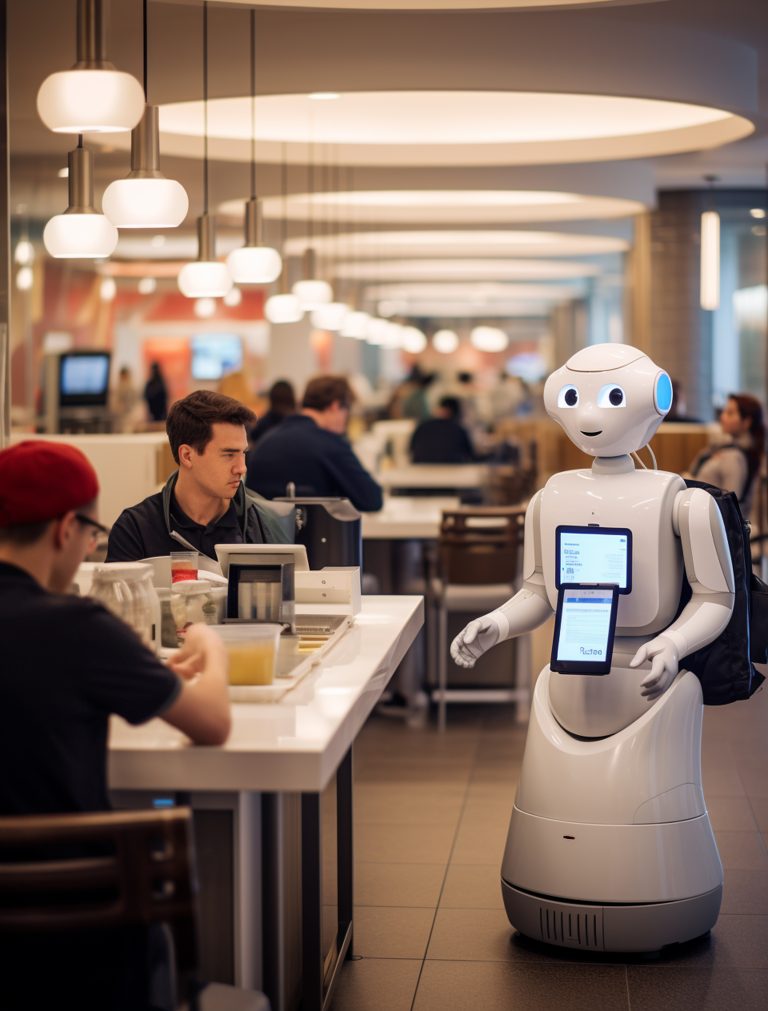By Reese Jones, Writer & Entrepreneur
The retail industry relies on constant digital innovations to keep up with shifting market trends and customer demands. According to research from Morgan Stanley, the most common technologies retailers now leverage include retail media, automation, and AI. Because of how effective they are for helping retailers stay on top of market trends, retail analyst Simeon Gutman finds that those best positioned in the industry can now experience margin expansion of more than 200 basis points over time. That’s up from around 9.5% on average today. By relying on innovations like automation, they’re cutting operational costs and boosting profitability, helping them improve the efficiency of up to 70% of routine tasks by 2025.
One of the most prominent and significant tech developments in the retail industry is the introduction of robotics. Today, not only are robots spotted in-store, but many companies are also employing robotic help for back-end processes like delivery fulfillment and storage automation. The novel concept may seem gimmicky at first, but the proper use of robots and robotics in retail can boost efficiency and business success. Below, we’ll look at the various ways robotics are transforming the retail industry:
Retail Installations For Marketing
A crucial element any retail business needs to succeed is marketing. Good and innovative marketing campaigns can help a retain business or brand stand out given the competitive market, especially in this age of social media. While online initiatives are certainly crucial for retail businesses to reach new customers, it’s also important to pay attention to in-store elements that can draw and retain foot traffic.
A good illustration of how robots can help in this case is Gentle Monster’s giant robot in the brand’s store in Galleria, Houston. A nine-foot-tall animatronic face that blinks and follows people within its field of vision, it was initially displayed upon the opening of this new location. While it doesn’t serve any technical purpose, the robotic face succeeds in gaining the attention of both the media and potential customers walking by. The robot also made its rounds on shortform video platform TikTok, where a user commented saying she drove over three hours just to visit the Galleria store where the robot is displayed. In an increasingly digital age, this particular use case for robots shows how important it is for retail businesses to not overlook the importance of physical store marketing.
Robots For Customer Service
Robots and robotics can also be impactful on customer behavior. These are usually designed to be humanoid in design so as to look relatable and familiar to customers visiting physical stores. A recent study in Japan suggests that even limited robot interactions can influence customer behavior. A service robot in a bakery shop that was built to greet customers and provide product information, for example, resulted in robot recommendations influencing purchasing decisions.
Today, in-store robots may be used to help assist customer inquiries on product or stock availability, as well as display or inform browsing customers about new or relevant products. The novelty can be useful for drawing more feedback and interaction from customers, and human employees can be tasked with other in-store activities to help keep up efficiency and productivity. Typically, these customer service robots function similarly to existing digital systems like chatbots or phone-based voice menus for addressing customers’ questions and needs, which can help reduce redundancy in human employees’ workflow.
Product Scanning Robots
In-store robots can also serve other purposes without having to interact directly with customers. For example, they can be used to roam physical stores and scan products to ensure they are in stock. ShopRite’s shelf-scanning robot does this as well as inventory tracking in over 20 stores in 2022.
Called Tally robots, the robots autonomously patrol the store up to three times a day. Using computer vision technology, the robots can scan products to check for stock availability and ensure products are placed in the correct aisles and location. Tally can also check that products are accurately priced on the sales floor. Since implementing these product scanning robots, ShopRite reported that it dramatically improved inventory operations by reducing low and out-of-stock items. Two years after introducing the robots into their system, nearly 70 ShopRite stores have implemented Tally.
Robots As Store Cleaners
Aside from customer interactions and product scanning, robotics are also perfect for more maintenance tasks — such as cleaning. Early in 2024, Japanese convenience store chain FamilyMart announced the deployment of cleaning robots across 300 locations to help support physical store managers and improve store operations’ efficiency. These cleaner robots are installed with capabilities such as fully automated sweeping and wiping, reducing in-store cleaning work by approximately one hour and enabling more time for human employees to do other tasks, such as sales floor development and store employee training.
On top of helping keep stores clean, these robots are also equipped with a small monitor to display and promote products along with product information and campaign announcements, much like the customer service bots discussed above. In the future, there are plans to add AI camera capabilities so the robots can record sales floor status during cleaning sessions, allowing store managers and supervisors to monitor store traffic. There are also plans to introduce a function to notify employees of product inventory status to ensure shelves are consistently stocked and replenished throughout the day.
Delivery Fulfillment
Finally, it’s important not to overlook the other growing side of retail business — ecommerce. In this case, robotics are especially useful for warehouse and storage operations, ensuring that product manufacturing, packaging, and distribution are on track and done accurately.
In 2017, Swedish ecommerce company Boozt partnered with tech company AutoStore to deploy a robotic fleet in its warehouse operations. This introduced a reliable, accurate, and fast automated fulfillment system where robots can sort through diverse inventory systems and select the right products for the right customers. Boozt now has over 1,150 robots helping process 190,000 items daily, helping the ecommerce business achieve a record-breaking 63-second order fulfillment. In a time when ecommerce businesses are filling an increasingly competitive market, businesses that leverage robotics technology for back-end processes like delivery fulfillment and warehouse management can stand out among the rest.
If you found this post insightful, you may like our previous post on “How AI and Automation Can Help Retailers Deliver a Seamless Experience”, where we discuss how these innovations help retail businesses boost personalization and support shifting customer behaviors.
About the author

Rachel James is a freelance writer and entrepreneur. She spends most of her time studying and writing articles about e-commerce trends to help out small-time business owners. When she’s not busy talking shop, you can bet she’s picking up a new hobby to learn, whether that be pottery throwing or reverse running.
Related Articles

The New Frugality: How Inflation and Tariffs Are Reshaping Consumer Spending
One of the most telling shifts is how shoppers approach decision-making. Where convenience once dominated, consciousness now plays a larger role. People are researching more before making a purchase, comparing prices across multiple platforms, and questioning whether they really need the product in the first place.

Embracing new concepts vs the return to brick-and-mortar
Balancing the return to physical retail and the development of new technologies to enhance customer experience and drive operational efficiency for long-term success.
Enartis to Acquire Parsec in Winemaking and Retail Deal
The deal will bring Enartis and Parsec together to help wineries manage every part of production more easily and efficiently, from grape to bottle.

A Practical Guide to Retail AI Use Policies for Retailers and HQ Teams
AI can bring new opportunities for retailers, but this innovation must come with responsibility.


 for the latest news and job opportunities in retail tech
for the latest news and job opportunities in retail tech 